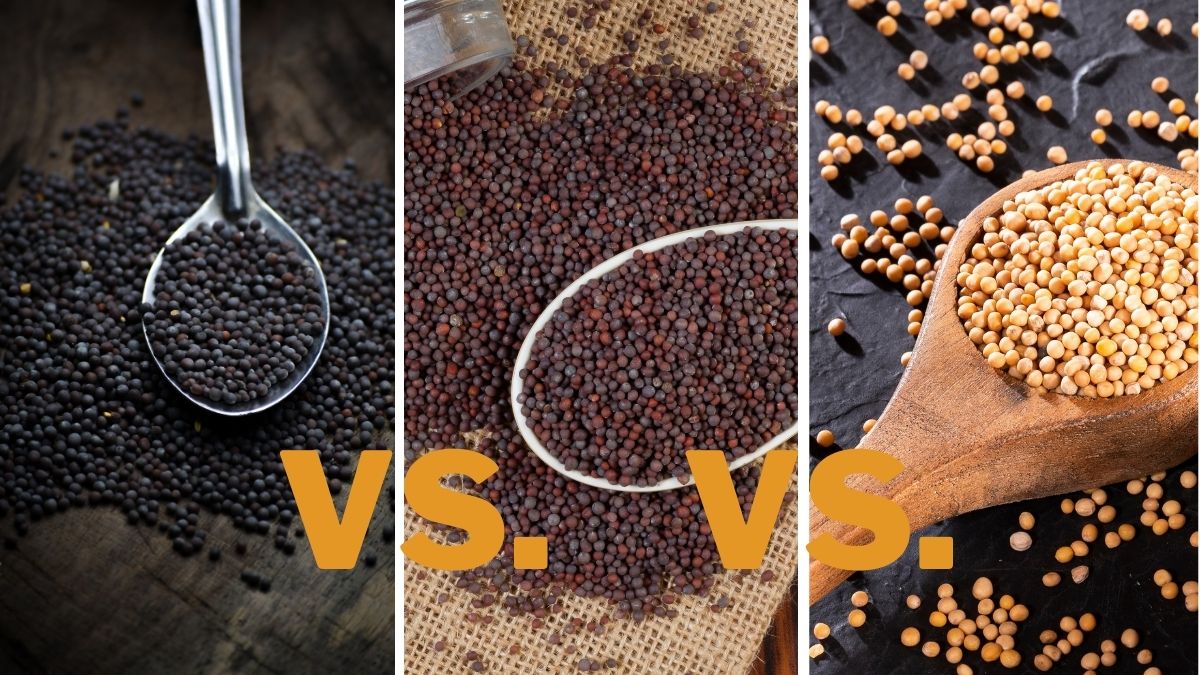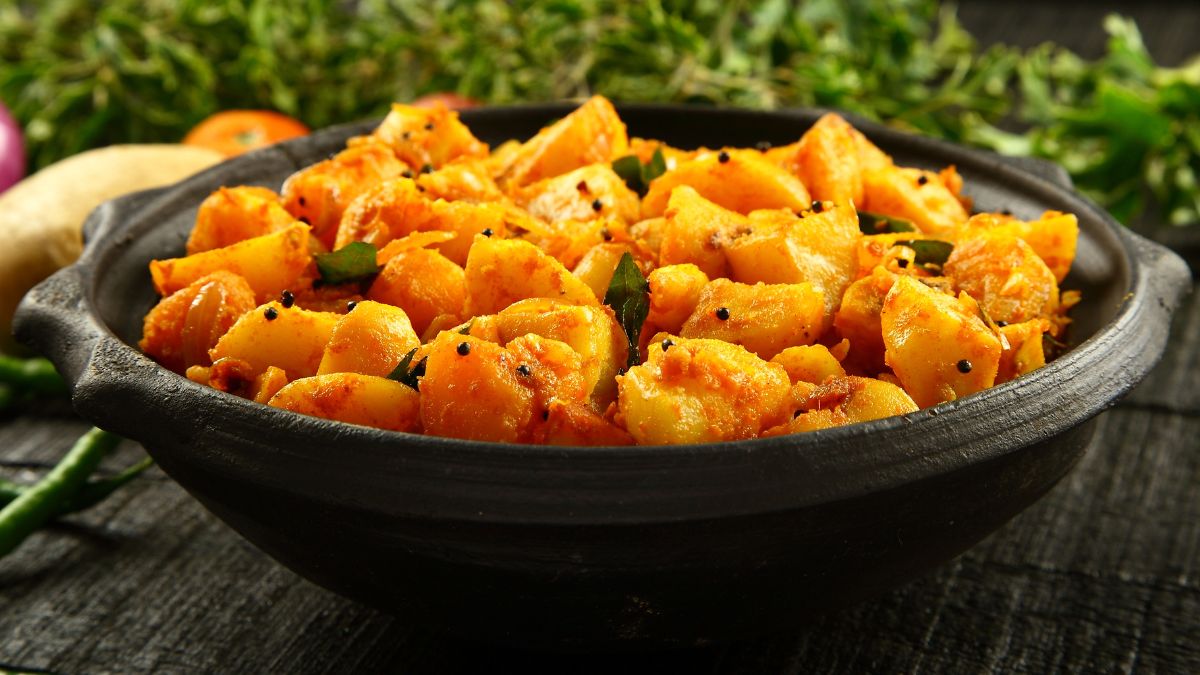Black vs. Brown vs. Yellow Mustard Seeds: Differences

I’ve always been a mustard fanatic. But not just any mustard — I’m talking about the good stuff, the kind with visible mustard seeds that deliver a burst of spicy flavor with every bite. You’ve come to the right place if you’re like me and love discovering new mustards with complex, tangy flavors. So, in this guide, I’m diving into the differences between black, brown, and yellow mustard seeds, from their colors and flavors to popular uses.
While black mustard seeds have the most intense flavor, yellow mustard seeds are the mildest of the three. Black mustard seeds are also the smallest, while brown and yellow seeds are similar in size, though yellow ones are usually slightly larger.
By the end of this, your fridge door will be covered in mustard stains, and you’ll be well on your way to becoming a mustard seed expert. Let’s get started!
Size
When it comes to mustard seeds, size definitely makes a difference. The three main types – black, brown, and yellow – vary quite a bit in size, impacting their uses.
As the smallest of the bunch, black mustard seeds are tiny, about 1 to 1.5 millimeters in diameter. Their petite size means they’re usually not used whole in cooking. Instead, the seeds are ground up to make a spicy mustard paste or powder.
Brown mustard seeds are a bit larger, around 2 to 3 millimeters across. The seeds are usually fried in oil until they pop, which causes them to become milder in flavor. The popped seeds add texture as a garnish or ingredient in dishes like potato curry or chana masala.
Of the three types, yellow mustard seeds are the largest, ranging from 2.5 to 3.5 millimeters in size. They’re the variety traditionally used to make American-style mustard. The ground seeds are mixed with liquids like water, vinegar, and wine to make popular condiments such as Dijon mustard and honey mustard. Because of their size, yellow mustard seeds are also often used whole as a pickling spice in recipes like bread and butter pickles.
While all three types of mustard seeds are spicy, the heat level can vary based on size and color. In general, the darker and smaller the seeds, the spicier they tend to be, and these are my absolute favorites. But no matter the size or heat, mustard seeds are a versatile ingredient that deserves a place in any well-stocked spice cabinet.
You can even grow them yourself and watch them grow day by day. But if you don’t have a green thumb, watching a timelapse video is quite satisfying, too.
The Heat and Flavor
Brown mustard seeds are slightly spicy but not overpowering. They have an earthy, tangy flavor with subtle nutty undertones from the seed itself. This mellower heat makes them perfect for dishes where you want the mustard flavor without too much punch.
Black mustard seeds have an intense, nose-tingling heat. They contain compounds called glucosinolates that break down into spicy chemicals called isothiocyanates when the seeds are crushed. The darker the seed, the more intense the flavor.
Yellow mustard seeds have an acrid, bitter taste and are the mildest of these three mustard seed options. They are the seeds used to make commercial yellow mustards. Because of their mild flavor, yellow mustard seeds pair nicely with various fresh or dried herbs.
Uses
Black mustard seeds are commonly used in Indian cuisine. They are a staple of fiery curries and vegetable dishes from southern India. You’ll also find them in dishes like sarson ka saag, a Punjabi dish of cooked mustard greens.
In addition to curries, black mustard seeds pair well in marinades and dressings. I like to make a spicy mustard vinaigrette with black mustard seeds, garlic, olive oil, and red wine vinegar to toss with hearty greens.
I like to use brown mustard seeds in Indian curries, bean dishes, and salad dressings. They pair especially well with ingredients like turmeric, cumin, garlic, and lemon juice. For extra flavor, toast the seeds in a dry skillet for a minute before adding them to your recipe.
Yellow mustard seeds are useful in many recipes thanks to their bold, zesty flavor. I love to:
- Add whole seeds to pickling brines, coleslaws, and potato salads. Their heat infuses into the vegetables and vinegar.
- Toss a spoonful of the seeds into marinades, rubs, and spice blends for meats like ham, sausages, and beef.
- Blend the seeds into vinaigrettes, aiolis, and creamy spreads. Their tang cuts through rich ingredients like mayonnaise.
- Sprinkle the seeds on pizza, flatbreads, and focaccia before baking for extra crunch and heat.
- Simmer whole seeds in braised green beans, collard greens, and other hearty greens. They impart flavor into the cooking liquid.

Which Mustard Seed Is the Best?
I have a hard time picking a favorite when it comes to mustard seeds. Each seed has its own distinct flavor and color that suits different tastes and purposes. Let me break down the pros and cons of each so you can determine which mustard seed reigns supreme for you.
Black mustard seeds have an earthy, nutty flavor with subtle spice notes. They are the smallest of mustard seeds and are often used in Indian curries and vegetable dishes. Black mustard seeds can be used whole as a curry spice or ground into a paste to make Chinese hot mustard.
Their robust, savory flavor pairs well with meats like pork or duck. However, black mustard seeds’ dark color and strong flavor may overpower some foods. They are an acquired taste and can be too bitter or spicy for some.
Brown mustard seeds are milder. They have an almond-like, tangy flavor with very little heat. Brown mustard seeds are often used to make Dijon mustard. They produce creamy mustard with a perfect balance of flavor and spice. Brown mustard seeds are very versatile and complement most meats, sandwiches, and salads.
However, they lack the robust flavor of black or yellow mustard seeds and may seem bland to those who prefer spicier mustards.
Yellow mustard seeds are moderately spicy and probably the mildest of the three mustards, with a wasabi-like kick. They are commonly used to make American yellow mustard. Yellow mustard seeds create a bright, tangy mustard perfect for hot dogs, bratwursts, and hamburgers.
Their bold flavor and spice also work well in marinades, dressings, and potato salads. However, the acidity and heat of yellow mustard seeds can be too overpowering for some and may not pair as well with more delicately flavored foods.
In the end, the best mustard seed comes down to personal taste. Whether you prefer the nutty and savory black seeds, the creamy and tangy brown seeds, or the spicy and zesty yellow seeds, mustard seeds of all colors have unique flavors that can elevate your cooking.
Why choose just one when you can enjoy them all? Tell me which one you’ll be enjoying first in the comments below!
